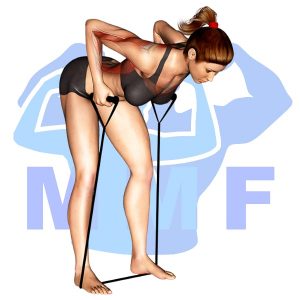Are you tired of not seeing results on your chest? Are you struggling to find a workout that truly isolates your chest muscles? A common problem many fitness enthusiasts face is the inability to target their chest muscles during their workouts. One exercise that can help alleviate this problem is the lying cable fly. It’s no secret that genetics play a role in how our muscles respond to training, but fear not, incorporating the lying cable fly into your workout routine can make all the difference. In this post, we will discuss the proper form for executing the lying cable fly and how it can help target your chest muscles.
Lying Cable Fly Summary
- Primary Muscles: Pectoralis Major – Sternal
- Secondary Muscles: Latissimus Dorsi, Levator Scapulae, Pectoralis Major – Clavicular, Pectoralis Minor, and Rhomboids
- Equipment: Cable Machine with Two Single D-Handles and Flat Bench
- Mechanics Type: Isolated
- Force: Push
- Utility: Auxiliary

Lying Cable Fly Instructions
- Setup up two opposing low pulley handles attachments.
- Next, lie down on a bench between the pulleys and perpendicular to both.
- With your elbows slightly bent, your elbows are back.
- Pull the cable handles together by maintaining your elbow fixed.
- Return to the starting position until your chest is stretched back out.
- Repeat these flys for a full set.
Video Tutorial
Lying Cable Fly Muscles
Target (Agonist)
- Pectoralis Major – Sternal
Synergists
- Latissimus Dorsi
- Levator Scapulae
- Pectoralis Major – Clavicular
- Pectoralis Minor
- Rhomboids
Dynamic Stabilizers
- None
Stabilizers
- Latissimus Dorsi
- Pectoralis Major – Sternal
- Pectoralis Minor
- Trapezius – Lower
Antagonist Stabilizers

Benefits of Lying Cable Fly
The lying cable fly exercise is an excellent way to target the pectoralis major – sternal muscle. When performed correctly, it can help to improve posture, increase chest strength and size, and build core stability. It also encourages proper breathing and helps to promote a healthy range of motion in the shoulder joint. Additionally, the lying cable fly can be done with a variety of weights and angles, making it easy to customize the workout for each individual’s specific needs. In addition to these benefits, the lying cable fly is also a great way to improve muscular endurance and coordination.
Tips for Performing Lying Cable Fly
You’ve come to the right place if you’re motivated to enhance your lying cable fly performance. Using these suggestions can allow you to maximize the advantages of this amazing exercise. Concurrently with shaping your chest muscles, improving mobility, and also a reduced possibility of injury can all be achieved with this exercise. So let’s get begin and look at what these tips can accomplish for you.
- Use Proper Form: It is important to ensure that your body is in the proper position when doing the lying cable fly. Keeping your back flat and core tight will help you get the most out of the exercise and prevent injury.
- Start Light: When first starting out with this exercise, use a light weight to ensure you are using proper form and technique. Starting with a light weight will also help build up your strength and prevent any muscle strain or fatigue.
- Take it Slow: Don’t rush through the exercise. Take your time to ensure you are getting the most out of each repetition and that your form is correct. Taking it slow will help you build up strength and endurance, leading to better results in the long run.
Benefits and Tips Video
Frequent Mistakes To Avoid
Staying away from mistakes can mean the difference between a productive workout and an injury when performing lying cable fly. Also, to maximize your benefits of the exercise, appropriate form is essential. By preventing these common mistakes, you will raise your ability to achieve your desired results. However, take it easy, it’s not as challenging as it might seem. By knowing the errors to avoid and taking the right actions, you can execute the activity safely and successfully. Let’s start by staying away from these standard errors and add this exercise to your training regimen.
- Not using proper form: Not using proper form when performing the exercise Lying Cable Fly can put strain on the wrong muscles and lead to injury.
- Not having the correct resistance: Using too much or too little resistance can limit the effectiveness of the exercise, so it is important to select the right resistance for your fitness level.
- Not monitoring your breathing: Not breathing correctly while performing the exercise Lying Cable Fly can lead to dizziness and a decrease in performance, so it is important to monitor your breathing throughout the exercise.
Find More Cable Exercises Here
Variations and Complementary Exercises
The exercise Lying Cable Fly is an effective way to target the chest muscles, but it’s not the only exercise that can help you achieve the results you want. Here are some variations, complementary, or alternative exercises that can help you achieve the same results:
Lunge Push Up

The Lunge Push Up is a great complementary or alternative exercise to the Lying Cable Fly. It is a compound movement that works both the chest and legs, making it a great full body exercise. Unlike the Lying Cable Fly, which primarily targets the chest, the Lunge Push Up incorporates more of the body’s stabilizing muscles. Additionally, this exercise can also be modified to increase or decrease intensity to suit the user’s fitness level. By adding a lunge to the push up, it engages the quads, glutes, and core, further strengthening and toning the body.
Feet Elevated Push Up

Feet elevated push ups are a great alternative or complementary exercise for the lying cable fly. This exercise is performed by placing your feet on an elevated surface such as a bench, box, or chair. With your feet elevated, you lower yourself into a push up position and perform the push up as usual. The elevation of your feet increases the difficulty of the exercise and works your chest, shoulders, and triceps more than a regular push up. This exercise is great for targeting those same muscles that are worked with the lying cable fly, but in a different way.
Close Grip Push Up On Knees

Close Grip Push Up On Knees is an excellent complementary exercise to the Lying Cable Fly. It works the same muscle groups and helps to strengthen the chest, triceps, and shoulders. This exercise is a great alternative for those who are unable to do the Lying Cable Fly due to limited equipment or lack of mobility in the shoulders. It is also ideal for those who are just beginning to build strength in their upper body. To do this exercise, start on your knees with your hands placed slightly closer than shoulder-width apart. Keep your core tight and lower your body towards the ground until your chest touches the ground. Push yourself back up and repeat for desired repetitions.
Check Out These Top Cable Exercises
Close Grip Push Up

Close Grip Push Ups are an excellent complementary or alternative exercise to the Lying Cable Fly. This exercise targets the chest and triceps in a slightly different way. By bringing the hands closer together, you are able to target the inner chest muscles and triceps more directly. The Close Grip Push Up also requires a greater degree of stability and balance as your body is positioned in a narrow plank position. This exercise can be performed anywhere with no equipment required, making it an ideal alternative to the Lying Cable Fly.
Lever Pec Deck Fly (Machine)

The Lever Pec Deck Fly is a great machine for targeting the chest muscles. It is a unilateral exercise, which means that each side of the chest is worked independently, allowing for a more balanced workout. This machine can be used as an alternative or complementary exercise to the Lying Cable Fly. It is beneficial in helping to target the lower chest muscles, which can often be neglected when doing cable flys. The Lever Pec Deck Fly also provides a more stable platform than traditional cable flys, allowing for greater control and safety during the exercise.
Standing Cable Chest Press

The standing cable chest press is a great alternative or complementary exercise to the lying cable fly. The standing cable chest press emphasizes the upper pecs and shoulders, working the muscles from a different angle than the lying cable fly does. It also allows for more range of motion and stability, allowing the user to generate more power and work the muscles more effectively. While the lying cable fly emphasizes the inner chest and arms, the standing cable chest press focuses more on the upper chest and shoulders, making it a great exercise to add variety to your routine.
Find More Chest Exercises Here
Opposing Complementary Exercises
If you are looking to complete your workout, pairing the exercise Lying Cable Fly with complementary exercises that work opposing muscle groups is a great way to ensure that your muscles stay balanced. Below is a list of exercises that you can add to your routine to target the opposing muscle groups.
Resistance Band Face Pulls

Resistance Band Face Pulls are a great complementary exercise to Lying Cable Flys as they work the opposing muscle group. Resistance Band Face Pulls work the muscles of the back, specifically the rear deltoids, rhomboids, and trapezius. This exercise targets the muscles of the back that are often neglected in many weight training routines. The resistance band face pull also helps to improve posture by strengthening the muscles of the upper back and neck, which helps to balance out the chest muscles worked during the lying cable fly. By performing both exercises, you can increase muscular strength, stability, and balance.
Resistance Band Bent Over Shoulder Rows

Resistance Band Bent Over Shoulder Rows are a great complementary exercise to Lying Cable Flys as they target the opposing muscle groups. By performing Resistance Band Bent Over Shoulder Rows, you can target the back muscles, specifically the latissimus dorsi, as well as the traps and rhomboids. This exercise is a great way to build strength in the back and balance out any strength gained from performing Lying Cable Flys. By working both the chest and back muscles, you can ensure that your body is balanced and prevent any muscular imbalances.
Resistance Band Bent Over Rows

Resistance Band Bent Over Rows is an exercise that is complementary to the exercise Lying Cable Fly. By targeting the back muscles, this exercise helps to balance out the chest muscles that are targeted in the Lying Cable Fly. Resistance Band Bent Over Rows works the posterior chain (back and shoulders) by engaging the latissimus dorsi, rhomboids, and teres major muscles while Lying Cable Fly primarily engages the pec major and minor muscles. This creates a balanced workout for the upper body, which is beneficial for overall muscular development.
Soar Above Your Limits With The Lying Cable Fly!
If you’re looking to take your chest workout to new heights, the lying cable fly is an exercise you need to try. With its intense focus on your chest muscles, this exercise is perfect for increasing strength and definition. The ability to adjust the cable height will allow you to target different areas of your chest for a well-rounded workout. Whether you’re a beginner or an experienced lifter, the lying cable fly will challenge you to push past your limits and soar to new heights in your fitness journey.
References: Wikipedia | ExRx.net | PubMed.gov | Comprehensive List of Chest Cable Exercises

